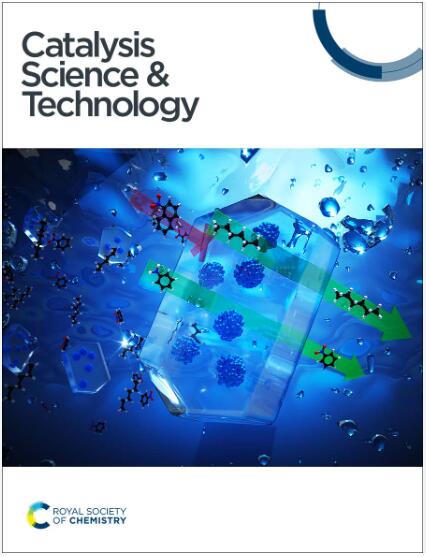Fluorite phase La–M–O (M = Zr and Ce) composite oxides for oxidative dehydrogenation of ethane at low or high temperatures: redox sites vs. lattice oxygen†
IF 4.4
3区 化学
Q2 CHEMISTRY, PHYSICAL
引用次数: 0
Abstract
La0.5Zr0.5O1.75 (LZ) without redox sites and La0.5Ce0.5O1.75 (LC) with redox sites, both possessing disordered defect fluorite phases, were successfully synthesized using a glycine nitrate combustion method. As oxidative dehydrogenation of ethane (ODHE) catalysts, LC and LZ exhibit good reaction performance at low and high temperatures, respectively. LC can achieve a C2H4 yield of 18.1% at 500 °C, while LZ can achieve a C2H4 yield of 39.4% at 700 °C. While both have intrinsic disordered oxygen vacancies, the Ce3+/Ce4+ oxygen storage cycle on the LC surface promotes oxygen mobility, thereby reducing the exchange temperature between gas-phase oxygen and binuclear reactive oxygen species O2− and O22−. The lattice oxygen of LZ is less active than that of LC, so it exhibits good high-temperature reaction performance. When designing and preparing A2B2O7-type catalysts for ODHE, the presence of redox sites in the fluorite phase is beneficial for low-temperature reaction performance, while the less active lattice oxygen in the fluorite phase enhances high-temperature reaction performance.
低温或高温下乙烷氧化脱氢用萤石相La-M-O (M = Zr和Ce)复合氧化物:氧化还原位点与晶格氧†
采用硝酸甘氨酸燃烧法成功合成了无氧化还原位点的La0.5Zr0.5O1.75 (LZ)和有氧化还原位点的La0.5Ce0.5O1.75 (LC),两者均具有无序缺陷萤石相。作为乙烷氧化脱氢(ODHE)催化剂,LC和LZ分别在低温和高温下表现出良好的反应性能。LC在500℃时C2H4产率为18.1%,LZ在700℃时C2H4产率为39.4%。虽然两者都存在固有的无序氧空位,但LC表面的Ce3+/Ce4+氧存储循环促进了氧的迁移,从而降低了气相氧与双核活性氧O2−和O22−之间的交换温度。LZ的晶格氧比LC的活性低,因此具有良好的高温反应性能。在设计和制备a2b2o7型ODHE催化剂时,萤石相中氧化还原位点的存在有利于低温反应性能,而萤石相中活性较低的点阵氧提高了高温反应性能。
本文章由计算机程序翻译,如有差异,请以英文原文为准。
求助全文
约1分钟内获得全文
求助全文
来源期刊

Catalysis Science & Technology
CHEMISTRY, PHYSICAL-
CiteScore
8.70
自引率
6.00%
发文量
587
审稿时长
1.5 months
期刊介绍:
A multidisciplinary journal focusing on cutting edge research across all fundamental science and technological aspects of catalysis.
Editor-in-chief: Bert Weckhuysen
Impact factor: 5.0
Time to first decision (peer reviewed only): 31 days
 求助内容:
求助内容: 应助结果提醒方式:
应助结果提醒方式:


